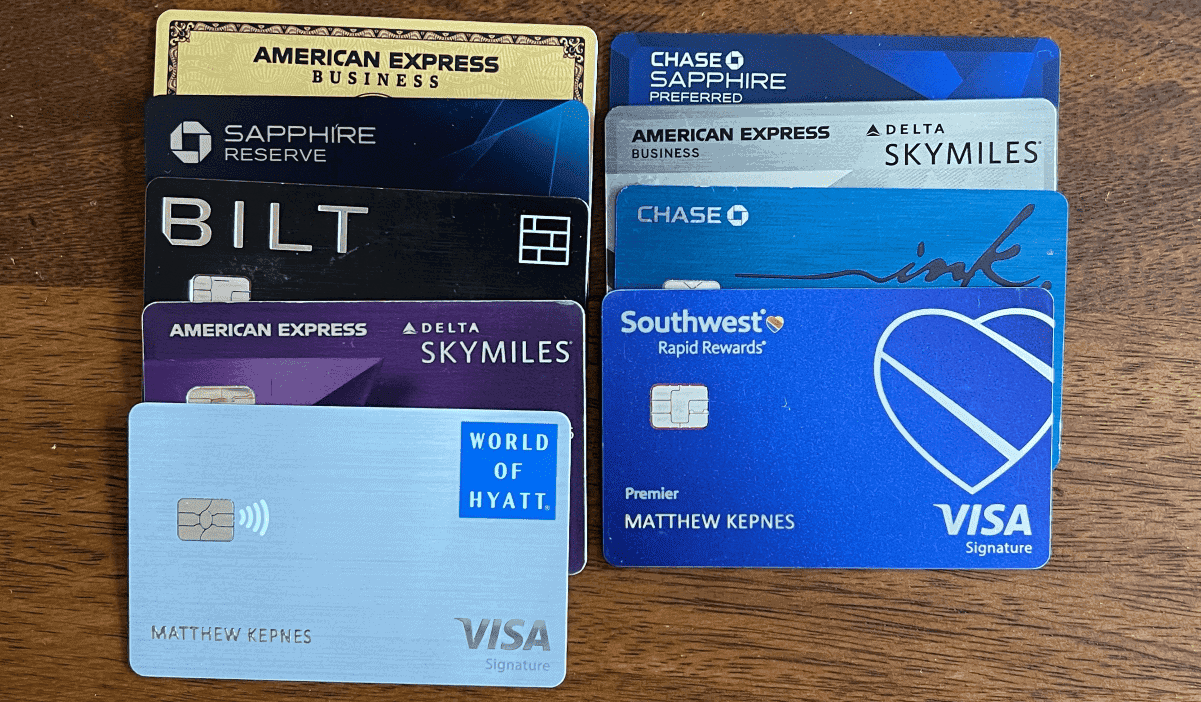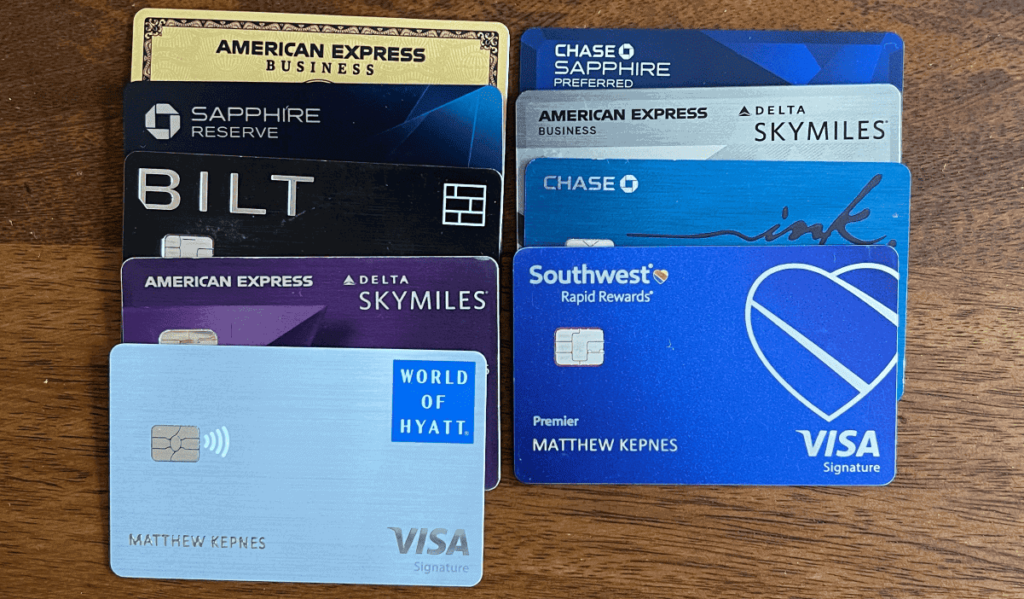
Posted: 10/9/2023 | October 9th, 2023
Getting — and using — credit cards is an essential component of any travel hacking strategy, yet there’s still a lot of fear surrounding them. And that’s understandable. Most of us have been taught at one point or another that credit cards are bad. They are often synonymous with debt, which can be debilitating.
But there’s much more to credit cards than just debt. When understood and used responsibly, their rewards and benefits can unlock the world for you.
That’s why, today, I wanted to dispel some of that fear surrounding travel credit cards by explaining exactly how credit cards work. By understanding the system, you’ll be that much closer to making it work for you!
How Do Credit Cards Actually Work?
Credit cards allow you to borrow money from banks, which you then pay back later. They basically facilitate a short-term loan. When you open a credit card, you’ll get a credit limit, which is the limit up to which you can spend. Each month, you can then spend as much as your limit allows.
If you pay that money back at the end of the month, there is no penalty. Your “loan” is paid off and next month you can spend up to that limit again.
If you don’t pay off your card at the end of the month, you’ll be charged interest on the remaining amount. A lot of interest (likely around 20%).
The key to travel hacking with credit cards is to never spend more money than you actually have, even if your credit limit is higher than that. You want to basically use your credit card like a debit card, spending only what you can actually afford, and then paying the balance in full each month. By doing so, you’ll avoid those hefty interest charges.
When used this way, travel credit cards can be an incredible tool for earning free flights, travel perks, and hotel stays — and all without spending extra money. Simply buy your groceries, gas, dinners outs — whatever you usually spend money on — with your travel credit card and pay off the balance each month. Do that, and you can enjoy all the positives (free travel) without the negatives (high interest rates). You’ll also improve your credit rating, which can help you down the road should you ever need to make a large purchase.
By using the system this way, you can get tons of free flights, hotel rooms, vacations, and even cash back. Best of all? It’s never been easier to earn points. You can even earn points on your rent now!
How to Get Started Using Credit Cards

If you’re new to using credit cards, you might not have much of a credit history and may not be approved for the best travel cards. If that’s the case, you’ll want to work on improving your credit.
To start, I recommend getting a secured credit card. This is when you pay a balance in advance (usually a few hundred dollars), which then becomes your credit limit. You can spend up to that amount and pay it off, thereby showing the credit card companies that you’re a responsible credit user.
Capital One and Bank of America both have secured cards to help you build credit. You can also check with your local bank or credit union to see if it offers any options (many do).
Another way to improve your score is asking to become an authorized user on the card of someone with good credit. This can help your score, though keep in mind that that person will be on the hook for the balance. Only do this with someone you trust, and don’t betray that trust by leaving them with the bill or hurting their credit score!
However you work on improving your score, as it goes up, you’ll be able to apply and be approved for unsecured cards, which are typically what you think of what you think of a credit card. You’ll likely want to start with no-fee travel cards as you get the hang of travel hacking, as they are generally easier to get.
Picking a Credit Card
There’s no perfect credit card, only the right credit card for you. Everyone has different goals, so first, you’ll want to determine your goals, so you can figure out which card will get you there. Not having a goal is one of the biggest travel hacking mistakes you can make, because it leaves you unguided, like a ship without a rudder.
Do you want your points to cover your hotel stay for your friend’s wedding next summer? Or maybe you want free flights to Mexico for a winter getaway. Maybe you care about making your travels more comfortable and want a more premium card that offers perks like airport lounge access.
Whatever the case, there’s a card out there for you.
Here are a few key things to look for when picking a card:
1. A huge welcome offer – These offers, also known as sign-up bonuses, are the fast track to a lot of points in a relatively short period of time. By spending a certain amount of money after opening the card, you’ll receive a bunch of points at once. For example, “unlock 60,000 points if you spend $3,000 USD within the first three months of having the card” is a standard welcome offer format you’ll see often. For reference, that amount of points could roughly be equal to a round-trip economy flight from the US to Europe, so these welcome offers should not be ignored. They’re the fastest way to get points and miles when you first start travel hacking.
2. Bonus earning categories – These are categories in which you’ll get more points than just one point per dollar spent (the default for most cards). For example, the Bilt card offers 3x points per dollar spent on dining, 2x points per dollar spent on travel, and 5x points on Lyft. If a lot of your spending falls in those categories, you can see how much easier it is to rack up points than if you were only getting 1x point for each dollar spent. Never accept one point per dollar spent. Look for at least two.
3. Travel perks that you’ll actually use – Travel cards are continually trying to outdo each other by adding different perks. Make sure that the card you choose comes with perks you’ll actually use! I personally prioritize lounge access, free checked bags, and priority boarding (on my airline credit cards), free hotel stays (on my hotel credit cards), and no foreign transaction fees (you should never ever get a card that charges these fees). But your priorities might be different, so find a card that works for you.
For a more in-depth look at picking a credit card, head to my dedicated post on the subject.
Common Travel Credit Card Perks
Travel rewards credit cards come with a variety of perks geared toward travelers. Generally, the higher the annual fee, the more perks you’ll receive, though even no-fee cards come with some rewards and benefits.
Here are some rewards and benefits that you can expect from most travel credit cards:
- No foreign transaction fees (that means you won’t have to pay an extra fee when using your card outside of the US)
- Travel insurance and protection (always read the fine print so you know exactly what it covers)
- Bonus earning categories (dining and travel are the most common ones)
- Ability to transfer your points to travel partners (to redeem them for free flights and hotel stays)
While many people are initially reluctant to pay an annual fee, cards with fees give you more perks, which can greatly outweigh the annual cost. In addition to the perks above, cards with fees also usually include:
- Bonus categories with higher earning rates (so you can rack up points faster)
- Airport lounge access
- Global Entry and TSA PreCheck fee reimbursement
- Travel and lifestyle statement credits
Hotel and airline cards come with perks like early check-in, free checked baggage, and priority boarding for that specific hotel or airline.
As you can see, there are a lot of benefits to having a credit card (or several) that’ll make your travels that much easier!
FAQ About Credit Cards
Do I have to pay off my balance as soon as I purchase something?
You don’t have to pay off your balance after every purchase. There is usually a grace period of a few weeks between your purchase and when the payment is due. As long as you pay your balance in full by the statement due date, you’re fine. “Carrying a balance” means paying past the due date — in which case, you’ll incur interest charges, something you never want to do as those negate the benefits of the card.
The average interest rate for credit cards in the US is 20%, so you always want to pay your debt in full each month.
Does opening a lot of credit cards hurt my credit?
While it’s true that opening and closing a lot of cards at once can briefly hurt your credit, applying for a few over a period of time won’t kill your score, which slightly dips every time there is an inquiry, whether that is applying for a credit card, home loan, or car loan. It’s how the system is set up. As long as you space out your applications and pay your bills each month, your credit won’t sustain any long-term damage.
How is my credit score calculated?
Many people mistakenly think that credit scores only have to do with whether you pay your credit card off on time. But credit card bureaus consider a variety of factors, including: your payment history, your credit usage (the percentage of your available credit that you’re using), how long you’ve been building credit, your credit mix (the different types of credit you have), and inquiries for new credit.
How do I find my credit score?
You can see your credit score and report for free by going to AnnualCreditReport.com. (Federal law requires each of the credit bureaus to give you a free report once every 12 months.) You’ll then be able to see what areas you need to work on, so you can start improving them.
How old do you have to be to get a credit card?
Technically, you can start applying for credit cards at age 18, though requirements make it difficult to actually get approved. You’ll likely have no credit history at this age and so will have to prove income, which can be difficult if you’re a student. Your best option for building credit if you’re between the ages of 18 and 21 is to get either a secured credit card or a student credit card, or become an authorized user on someone else’s card. After age 21, these restrictions fall away, and it becomes easier to get a “normal” credit card.
Over the years, I’ve enjoyed tons of free flights, free upgrades, free hotel stays, and other perks just by using credit cards. There’s no reason you can’t be enjoying those too. As long as you pay off your balance each month, you can use your everyday purchases to earn free travel and other incredible perks — all without extra spending.
Don’t leave money on the table. Start travel hacking today!
Book Your Trip: Logistical Tips and Tricks
Book Your Flight
Find a cheap flight by using Skyscanner. It’s my favorite search engine because it searches websites and airlines around the globe so you always know no stone is being left unturned.
Book Your Accommodation
You can book your hostel with Hostelworld. If you want to stay somewhere other than a hostel, use Booking.com as it consistently returns the cheapest rates for guesthouses and hotels.
Don’t Forget Travel Insurance
Travel insurance will protect you against illness, injury, theft, and cancellations. It’s comprehensive protection in case anything goes wrong. I never go on a trip without it as I’ve had to use it many times in the past. My favorite companies that offer the best service and value are:
Want to Travel for Free?
Travel credit cards allow you to earn points that can be redeemed for free flights and accommodation — all without any extra spending. Check out my guide to picking the right card and my current favorites to get started and see the latest best deals.
Ready to Book Your Trip?
Check out my resource page for the best companies to use when you travel. I list all the ones I use when I travel. They are the best in class and you can’t go wrong using them on your trip.

